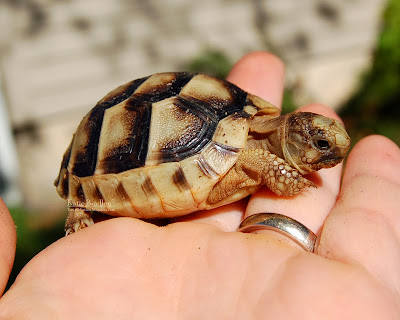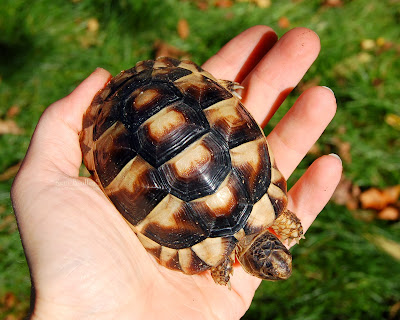This year the Russian tortoises are hibernating (brumating). I have wanted to do this for several years now, but was scared of it. I have done a ton of research over the past few years, and am confident that I can safely allow them to hibernate now.
 |
| Timmy, Mila, Roz and Jill get to hibernate this year |
Hibernating your pet Russian tortoise is not absolutely necessary. I know several very knowledgeable keepers who have never hibernated their tortoises. However, my Russian torts have 'tried' to hibernate every year. They stopped eating, and I had to wake them up daily to try to keep them from shutting down for the winter. Because they were at room temperature (which is NOT a safe hibernation temperature!), they lost weight during this time. Everyone bounced back and started eating again in the Spring, but this year I want to let them hibernate properly.
 |
| These are the 4 Russian torts last Spring after NOT hibernating. |
Several considerations are important before attempting hibernation:
-The tortoise must be healthy. No worm infestation, no protozoan infection, etc. - it may be a good idea to have the vet check a fecal sample to be sure. If your tortoises live outside, it may be a good idea to treat them with panacur (fenbendazole) just to be on the safe side.
-The tortoise must have a healthy weight. There are calculators online for different tortoise species that will tell you whether your tortoise is within a healthy weight range. As a general rule, a tortoise should always feel heavier than expected when you pick it up.
-You should have had your tortoise for more than a year. If you have had it for a shorter duration, wait a year - it's too risky, especially if you don't know much about its' history.
-Location. Where will you hibernate your tortoise? Whether you attempt a fridge hibernation (read how first!) or hibernate in your garage (not a detached shed unless you can control the temperature!), it is important that the temperature is right around 40 degrees F (4.5 degrees C). If it is warmer, your tortoise will burn too many calories. If it is colder, your tortoise may freeze to death.
-Hibernation container: be sure that air can come in, but that rodents cannot. The tortoise will not be able to move away to protect itself during hibernation. Avoid tragedy - better safe than sorry!
 |
Lady, our large female, is at a healthy weight,
but we have only had her since last April, so I won't hibernate her yet this year. |
Timmy, Mila, and Roz are going down for hibernation (brumation) today. Jill is about 2 weeks behind them, since the room she is currently in is very warm and she is still very active. I'll be moving her to the big table to start slowing her system down once the other 3 are packed up. Lady, whom I have had for less than a year, is going to stay up - I want to be very sure that she is healthy before she gets to hibernate (probably next year). I've raised the temperatures in the room her tortoise table is in, and she is still up every day, basking, soaking, and eating.
 |
| Allegra the rescued redfoot tortoise DOES NOT hibernate! |
Not all tortoise species hibernate. Redfoot tortoises, yellowfoot tortoises, sulcata, some Greek tortoise subspecies, pancake tortoises, leopard tortoises and several others stay awake.
Please be sure to research whether your tortoise species hibernates before attempting this!
The first step in hibernation preparation is to provide a fasting period that still includes regular soaking. You don't want any food to be left in your tortoise's gut, because it could rot or ferment in there and cause your tortoise to die. Timmy and Mila naturally stopped eating, and spent most of the days and nights in their hide already. I stopped offering food 3 weeks before hibernation start. For the first 2 weeks, I soaked them every 3-4 days, and left the basking lights on. For the last week, I turned off all basking lights, and soaked them every 3-4 days. At this point, their guts were empty.
 |
When 3 tortoises soak in warm water for 30 minutes, and the water stays clean...
you KNOW their guts are empty! |
Over the course of last winter, I measured the temperature in different parts of our garage. I found that even on the coldest days, the temperature on a shelf near the furnace never dropped below 40 degrees F (4.5 degrees C). This is perfect for hibernation. However, I have also found that the garage has a tendency to warm up to 50 or even 55 degrees F on warmer winter days, so I have decided on using the refrigerator hibernation method after a few days of 'cool down' in the garage.
Some people let their tortoises brumate naturally outside - however, for me this is not an option, as it rains torrentially here for much of the Fall and Spring, and I would be worried that the sleeping tortoises would flood and drown inside their burrows. A more controlled environment is more suitable.
 |
| Jill, having her pre-hibernation weigh-in |
My tortoises are worm-free, and have a healthy weight. Tortoises should not lose more than 1% of their weight during hibernation. I recorded each tortoise's weight in the little booklet I keep.
Next, I placed each of the tortoises into a box filled with coconut coir. I figured that they would like the familiar substrate, and that the coir would provide a little insulation.
 |
| Roz is not entirely thrilled about being stuck in a small box |
Next, I placed the 3 boxes into a small 10-gallon terrarium that I had filled with packing peanuts and newspaper for extra insulation. With the wire mesh lid on, placed up high on a shelf, I felt that the tortoises would be safe from any rodents that might make their way into the garage.
 |
| My little helper, posing with the packed-up tortoises |
I placed the terrarium in the garage, to let the tortoises cool down to 50 degrees for a few days. This plan backfired just a little - two days later I walked past the terrarium, and found Roz OUT of his box, wedged vertically between his box and the glass. I got the terrarium down, and found that all 3 tortoises had dug out of their boxes, and were slowly moving around in their little glass safe box.
Thankfully, I had been monitoring our refrigerator temperatures, and so I knew that the crisper drawer held a steady 39 - 41 degrees F (3.8 - 5 degrees C). I lined one of the crisper drawers with newspaper, then placed some old towels inside. Then I placed the tortoises into the drawer.
 |
| I'd like those sleeping tortoises with a side of carrots, please. |
Next, I put several more layers of towels over the tortoises, tucking them in all around. I expected them to move around a little for a few days, and they did. I had to re-tuck them in a few times, because they moved out of their towel nest. Even with steady temperatures of a modern fridge, I didn't want them down on the plastic or too close to the back of the fridge. After day 4 they stayed put.
 |
| Night-night, little tortoises! |
In the meantime, Jill is safely tucked into this drawer as well. I will be checking on them and weighing them once a week.
Counter to what is commonly believed, it IS safe to carefully handle your tortoise during brumation, as long as they are not warmed up. In fact, checking their weight and making sure they are healthy is very important. The plan is to let them hibernate for 10-12 weeks, so I will be waking them up in mid-late February.
IMPORTANT:
1.) Even during brumation, tortoises continue to breathe, although very slowly.
The refrigerator needs to be opened at least once daily to allow fresh oxygen to come in!
2.) If you are doing a refrigerator hibernation,
make sure that the temperatures don't ever drop below freezing. Measure the temperatures in the actual location you plan to place your tortoise - some refrigerators have cold spots (you know, like when the milk suddenly freezes). Use a good digital thermometer with a max/min record.
Not as important, but possibly a useful hint: If you frequently have guests, or someone will be house-sitting for you, you may want to put a little sign on the crisper drawer to avoid shocked reactions at accidentally coming across a sleeping tortoise while searching for an apple!
This blog post narrates my procedure, but PLEASE do lots of research on your own before attempting this yourself! Here are a few useful articles about safe hibernation that I read and found useful:
http://www.tortoisetrust.org/articles/newhibernation.html
http://www.tortoise-protection-group.org.uk/site/files/Fridgehibernationmethod.pdf
http://russiantortoise.net/hibernation_journey.htm




























